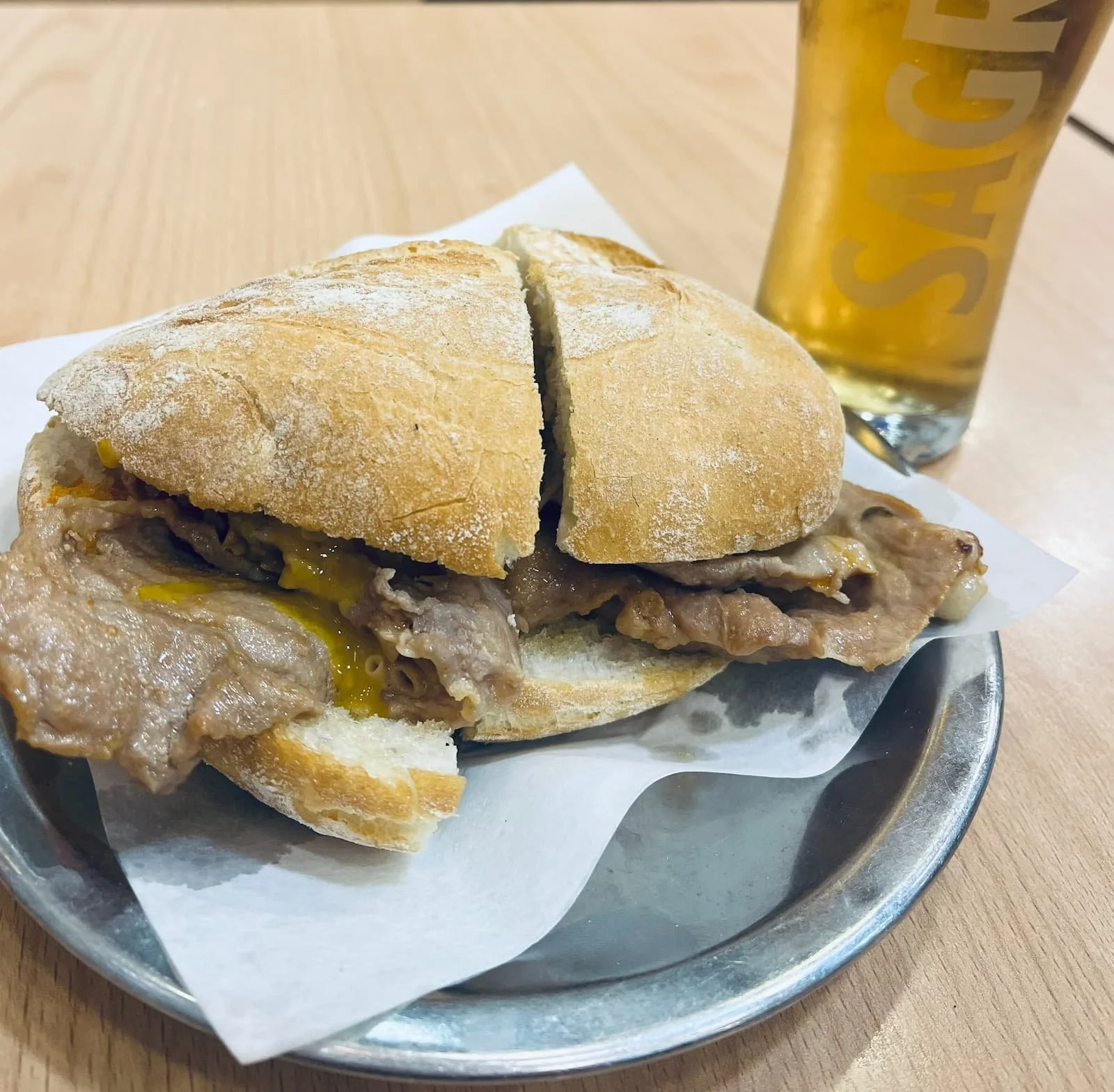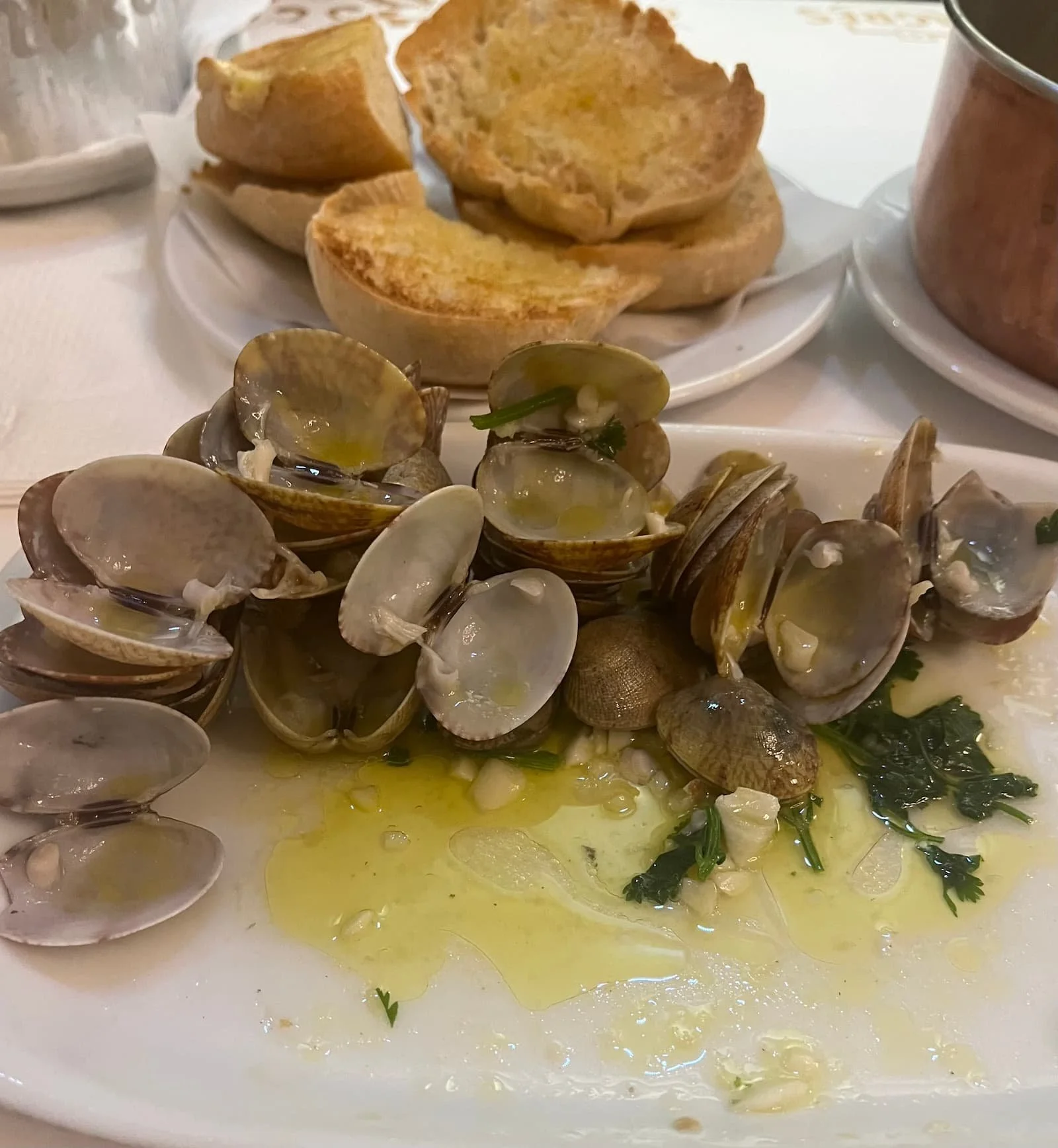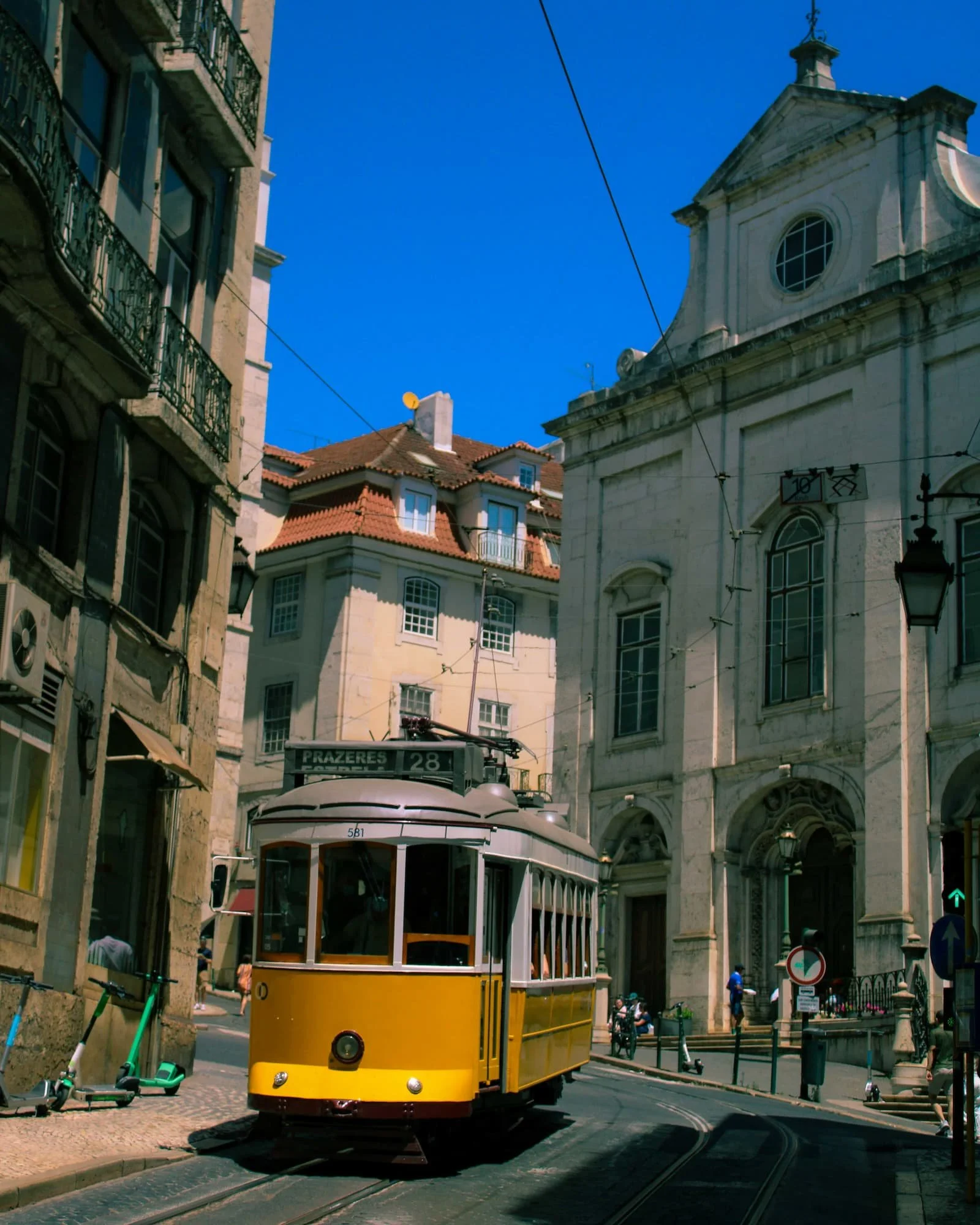A Laid-Back 2 Day Lisbon Itinerary
Later in this post I share a few affiliate links. I may earn a commission if you click on them and make a purchase, at no cost to you. I really appreciate your support!
Earlier this year, when the late winter gray of Germany was just too much to handle, I planned a quick weekend getaway to Lisbon, Portugal.
I love a good weekend trip, but I hate feeling pressured to see and do *everything* that a city has to offer in just a brief 48 hours.
FORTUNATELY, LISBON IS AN IDEAL DESTINATION FOR A 2 DAY VISIT.
Lisbon blends its vibrant, Portuguese culture with a relaxed atmosphere that allows visitors to explore its charms at their own pace.
From historic neighborhoods like Alfama to iconic sights like Belém Tower, there's always something to discover.
But Lisbon is also perfect for vibing about, just taking in stunning views from the city’s many miradouros or savoring local cuisine at quaint cafés.
It's that balance that I loved during my visit to Portugal’s capital city. Here’s my recommended itinerary, a perfect blend of activity and relaxation.
A LAID-BACK 2 DAY LISBON ITINERARY
Top Experiences in Lisbon
🔍 Discovery | Learn more about your destination
🤝 Connection | Meet locals and trade stories
🎭 Performance | Immerse yourself in the local art and culture
🚌 Excursion | Explore nearby places of interest
Curious how to find the best experiences no matter what destination you visit?
Download my Europe Experience Planner now!
Lisbon Itinerary - Day One
8 a.m. Pastelaria Breakfast
On your first day in Lisbon, grab a quick breakfast at one of the city’s pastelarias.
These Portuguese bakeries sell a variety of breads and pastries, though perhaps none is more renowned as a symbol of Lisbon than the humble pastel de nata.
You can’t visit Lisbon without trying Pastel de Nata.
The pastel de nata is a custard tart with a flaky, buttery crust and a creamy, sweet custard filling. Its custard is often slightly caramelized on top, giving it a delightful crunch when you bite into it. 😋
Paired with a cup of coffee, this humble tart will power you through a morning of exploring the city on foot.
RECOMMENDED:
Purists will want to seek out Pastéis de Belém, the original bakery where the pastel de nata was invented, while others may want to try Aloma for its award-winning versions. The historic Confeitaria Nacional also gets high marks for their version. If you want to try the highly popular Manteigaria for their pastel de nata, be warned that you may have to wait in line!
10 a.m. Walking Tour of Lisbon
My favorite thing to do on my first day in any destination is to take a tour to learn more about the history of the place.
It’s like getting a healthy dose of gossip on the place. 🤫
While I love discovering things on my own (well, with the help of Wikipedia on my iPhone), it is a much better use of your limited time to take a guided walking tour.
In Lisbon, there are two walking tours that I think are *essential* and completely different from one another.
The Best of Lisbon Walking Tour will guide you through the city’s three most popular neighborhoods, this historic, moorish Alfama, the vibrant cultural hub of Chiado, and grand, bustling Baixa.
The Arco da Rua Augusta, gateway to Praça do Comércio, was built to commemorate the city's reconstruction after the 1755 earthquake.
This tour is especially great for architecture and design fans!
You’ll explore the open-air ruins of Carmo Church, a Gothic church which was partially destroyed in the great 1755 earthquake, and stroll through Praça do Comércio, a grand, riverside square and one of Lisbon's most iconic landmarks.
This is a prime photography spot, so be sure to bring your camera! 📸
The Arco da Rua Augusta anchors the entry to the square, while the equestrian statue of King José I is often photographed with the bright, yellow buildings in its background.
The square sits directly on the Tagus River, so don’t forget to take some photos capturing Lisbon’s waterfront atmosphere, too.
You’ll also visit Rossio Central Station, a 19th-century train station and one of the quintessential examples of Neo-Manueline architecture.
Belém Tower, one of Lisbon’s most iconic landmarks, dates all the way back to the 16th century.
A second walking tour option is the Belém Journey Walking Tour, which reveals the history of Portugal’s Age of Exploration through a series of UNESCO World Heritage sites.
This tour, while also a great choice for my architecture fans, will be especially intriguing for history buffs who are curious about how a small nation like Portugal used their maritime skill to launch the Age of Exploration in the 15th and 16th centuries.
This tour will take you to the Jerónimos Monastery, a stunning UNESCO World Heritage site built to commemorate Vasco da Gama's voyages, as well as the Monument of the Discoveries, itself a testament to Portugal's maritime explorers.
You’ll also tour the Belém Tower, a fortress built in the early 16th century to protect the city.
It's one of Lisbon's most iconic landmarks. 📸
1 p.m. Lunch
Skip the white tablecloth restaurants (and save a bit of time ⏰) by trying an authentic Portuguese bifana for lunch.
Bifana is a traditional sandwich featuring thinly sliced pork that’s been marinated in garlic, white wine, and spices, then grilled and served in a crusty roll.
I love a quick lunch, and the Portuguese bifana definitely hit the spot.
It's simple but delicious, and can be dressed with mustard or piri-piri sauce.
Chiado spot O Trevo has been popular for its bifana ever since Anthony Bourdain stopped by.
I enjoyed this quick, no-frills lunch of bifana and beer - in and out - in less than fifteen minutes.
Other spots for a bifana inclue A Brasileira, housed in a grand, 100 year old building in Chiado, and The Bifanas of Afonso in Baixa. If you’re close to Rossio Train Station, try nearby Beira Gare for their bifanas and seafood.
3 p.m. Visit The Calouste Gulbenkian Museum
Head to the Calouste Gulbenkian Museum for a late afternoon helping of art and history.
Created from the private collection of Armenian-British oil magnate and philanthropist Calouste Gulbenkian, the museum houses a vast collection of art from antiquity to the twentieth century.
Its galleries include pieces from Egypt, Persia, and European masters like Rembrandt and Monet.
I love the personal element to be discovered in a private museum, the unique tastes and interests of the founding collector.
Expect to spend about an hour to an hour and a half walking through the Calouste Gulbenkian Museum.
This is very different from the collections of large institutions like the Met or the Louvre, which are often government funded and exhaustive in their collections.
It’s precisely that kind of intimate, curated experience that’s on display at the Gulbenkian - it may lack a comprehensive scope, but it displays the evolving tastes and interests of its founder.
GETTING THERE:
From the city center, take the metro to São Sebastião station. The museum is a short walk from the station.
6:30 p.m. Sunset Views at Lisbon’s Miradouros
The Portuguese word miradouro refers to a viewpoint or lookout spot that offers panoramic views of a city, landscape, or coastline.
In Lisbon, miradouros are located on several of the city's many hills.
They’re popular gathering spots where you can enjoy stunning vistas of the city’s rooftops, landmarks, and the Tagus River.
Life really is good when you’re able to relax and take in this sunset view from Miradouro de Santa Catarina.
Despite their great views, miradouros aren’t just for sightseeing, though.
They’re social third spaces where locals and travelers alike gather to take photos, enjoy a drink and listen to live music.
RECOMMENDED MIRADOUROS:
I loved the laid-back atmosphere at Miradouro de Santa Catarina. There was live music and a nearby kiosk serving drinks. The view over the river towards the 25 de Abril Bridge was breathtaking at sunset.
Miradouro da Senhora do Monte boasts commanding panoramic views over the city, including the castle and the Tagus River. It's a favorite for sunset lovers, but with no nearby kiosks, be sure to bring your own libations.
The most famous, in my opinion, is Miradouro de Santa Luzia. It has fantastic views of the Tagus River. Visitors love to take photos under its azulejos-adorned pergolas, often in bloom with bougainvillea. 📸
9 p.m. Seafood at Cervejaria Ramiro
Dinnertime on the Iberian Peninsula traditionally begins later than in other parts of Europe.
Do as the locals do and book a 9 p.m. table at Cervejaria Ramiro, home to arguably the best seafood in Lisbon.
Try the garlic butter clams or the carabineiros - large scarlet prawns, grilled to bring out their intense flavor.
The aftermath of the garlic butter clams - which I basically inhaled - at Cervejaria Ramiro.
Their sapateira recheada (stuffed crab) is the stuff of legend: a hollowed-out crab shell filled with a rich mixture of crab meat and sauces.
(It’s billed as a dish for two people minimum, but I’m not ashamed to admit that I ordered one for myself on my solo trip to Lisbon 😎.)
More adventurous eaters might try the percebes, (goose barnacles), and lots of folks like to order the prego no pão, a traditional steak sandwich served as a post-seafood treat.
11 p.m. After Dinner Drinks
For a small nightcap, walk to the famous A Ginjinha, near Rossio Square, and try local specialty Ginjinha.
Ginjinha is a sweet, traditional Portuguese liqueur made by infusing sour cherries (ginja berries) in alcohol, along with sugar and sometimes spices like cinnamon.
It’s served in small shot glasses, often with a cherry at the bottom.
A Ginjinha is a popular spot near Rossio Square to try the sweet, cherry flavored Ginjinha liqueur.
If you’re looking for a variety of tipples, explore Lisbon’s cocktail bar scene.
Monkey Mash is known for its tropical-inspired libations, while its sister establishment, Red Frog Speakeasy serves innovative cocktails in a dimly lit, speakeasy-inspired setting.
Pensão Amor, an eclectic bar located in a former brothel in the Cais do Sodré district, combines creative cocktails and themed decor. It has a great mix of bohemian charm and buzzy energy.
Lisbon Itinerary - Day Two
11 a.m. Discover Portuguese Cuisine
One of my favorite ways to connect with a destination is by taking a cooking class.
You learn so much about the culture of a place through food - why certain dishes and customs became popular, or how meals are created and shared among locals.
Book this Traditional Portuguese Cooking Class and over the course of 3 hours, you’ll prepare a 4-course meal with step-by-step guidance from local chefs.
The menu changes seasonally to showcase fresh, local ingredients, but those iconic Pastel de Nata are always on the menu.
I love connecting with other travelers during cooking classes, too, especially over a glass of wine. (Fret not, sober friends: there are non-alcoholic options available as well.)
Regardless of whether you're a novice in the kitchen or a seasoned home cook, this small-group class promises a fun, immersive cultural experience.
COOKING CLASS NOT REALLY YOUR THING?
Then book this Undiscovered Lisbon Food & Wine Tour and explore hidden gems of the Baixa and Mouraria neighborhoods food scene.
This tour includes seven different tastings of authentic Portuguese cuisine, paired with local wines and beers.
Along the way, learn about Lisbon’s vibrant street art, international influences, and the soulful Fado music tradition.
It’s perfect for food lovers who want to pound the pavement and explore Lisbon’s neighborhoods at the same time.
2 p.m. Take a Ride on Tram 28
Tram 28 is one of the most popular of Lisbon’s iconic vintage trams, which date all the way back to the 1930s.
Its route covers many of the city’s landmarks and includes areas like Alfama, Baixa, and Bairro Alto.
I love this leisurely route for the fantastic views and a great snapshot on everyday life in Lisbon.
Start at Martim Moniz, a lively square with shops and street food vendors, and board Tram 28 in the direction of Campo de Ourique.
Tram 28 is one of Lisbon’s most popular trams, with a route that winds through many of the city’s top neighborhoods.
You’ll ride through the Alfama district, passing by the imposing São Jorge Castle, and eventually on past Sé de Lisboa (Lisbon Cathedral), one of the city's oldest churches.
From there, you’ll ride through the Baixa area with its grand squares and classic architecture, including the Praça do Comércio.
Through the Chiado and Bairro Alto neighborhoods, you’ll spot vibrant shops and cafés, eventually arriving at Campo de Ourique, a more residential area with local shops and markets.
A full ride on Tram 28 from Martim Moniz Square and back typically takes around 40 to 50 minutes.
The duration can vary depending on traffic, the time of day, and how crowded the tram is.
The tram loop eventually returns to Martim Moniz, so you can enjoy the entire route or hop off at various points of interest along the way.
I suggest hopping off in Chiado or Bairro Alto and meandering through its shops and cafés.
Giving yourself a few hours of time to wander through a city is a great way to make your itinerary feel less restrictive.
6:30 p.m. Sunset and Wine Sailing Tour
Enjoy your second sunset in Lisbon on the water, trading in miradouros for a sailboat. ⛵
This Sunset and Wine Sailing Tour allows you to sip Portuguese wine while enjoying the sites of Lisbon from the Tagus River.
Sail past the 25 de Abril Bridge, which spans the Tagus River.
In addition to a leisurely sail, the skipper will highlight famous sights, like the Ajuda National Palace, Jerónimos Monastery, and 25 de Abril Bridge, as they pass by.
Be ready to ask questions of the skipper, as this small group excursion allows for plenty of personalized attention.
10:30 p.m. Dinner and Fado
For a final hurrah in Lisbon, book a late table for Dinner and Fado.
Fado is a traditional Portuguese music genre characterized by its melancholic and soulful melodies.
The lyrics often express themes of longing, nostalgia, and passion.
Fado is usually performed with a solo vocalist accompanied by the Portuguese guitar and classical guitar. Fado reflects Portugal’s emotional depth and history, and a unique glimpse into Portugal's musical heritage.
Visiting one of Lisbon’s Fado Houses requires a reservation, so be sure to plan in advance.
They tend to have a more refined atmosphere, so aim for a smart-casual dress code.
The menu is likely to be fixed with a few options per course, and communal seating is not uncommon.
Overall, taking in a Fado show is a fantastic way to experience Portuguese culture, and its melancholy soul is a fitting background for your final night in Lisbon. 😔
RECOMMENDED:
In Bairro Alto, historic Fado house Adega Machado combines gourmet dining with live Fado music.
Over in Alfama, Clube de Fado offers a classic Fado experience with traditional Portuguese dishes in a cozy setting.
Is 2 Days Enough Time to Visit Lisbon?
I actually love the lack of “must-do” sights in Lisbon.
It gives visiting the city a completely different vibe than, say, Paris or London, where you almost feel duty-bound to see all of the biggest sights and museums.
I find that two days is enough to see most of the popular and historic sights of Lisbon, as well as leaving time for culturally immersive experiences like a Fado performance or a cooking class.
If you’re looking to explore more of Lisbon or its surrounding areas, though, budget for more than two days.
Lots of folks rave about taking a day trip to Sintra or a day trip to the Algarve, too.
Just know that if you are short on time, two days in Lisbon will leave you feeling refreshed, enriched, and ready to plan your next visit!
PLANNING A VACATION?
When you book through my links, you help support the site — at no extra cost to you.
Thanks for being a part of the Notes From Here journey! ❤️
💃 Book Tours and Experiences with Viator
🛎️ Find Hotels with Booking.com
🚗 Find a Rental Car with Discover Cars
🚅 Book a Train with RailEurope
🛡️ Get Travel Insurance with SafetyWing
🎩 Arrange Private Transfers with DayTrip
🚌 Book a Bus or Ferry with Omio
YOU’LL ALSO LOVE…















